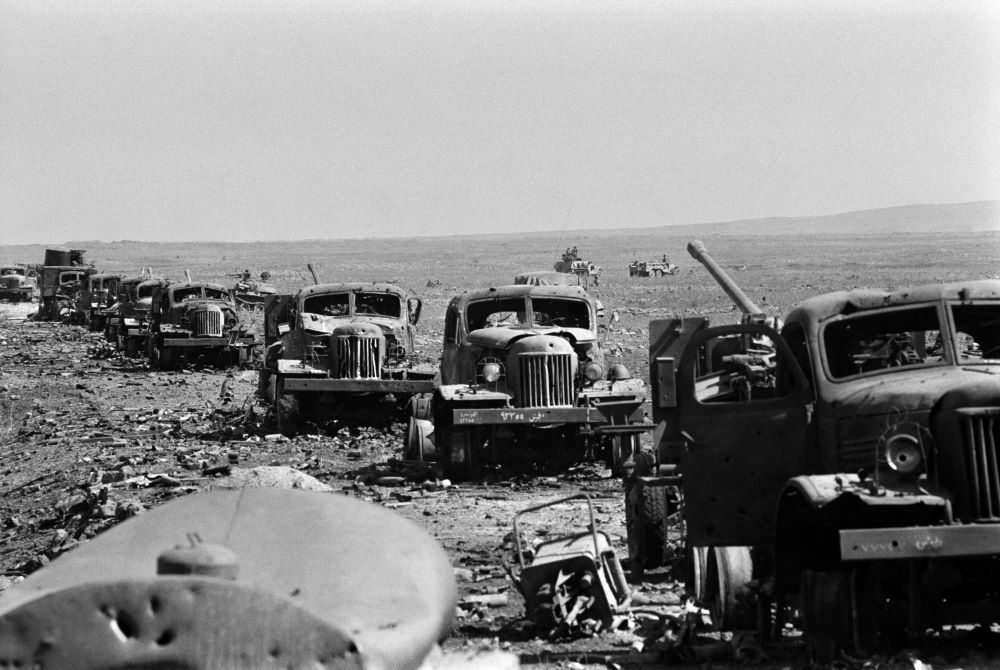- Home
- War in the Middle East
- The Golan Heights, a Strategic House of Many Mansions

©A Syrian military convoy destroyed by the Israeli army is abandoned on the Syrian front lines on the Golan Heights, in October 1973.
The Golan Heights, a rocky plateau where 12 youths were killed Saturday amid clashes between Lebanon's Hezbollah and Israeli forces, is a strategic territory partially captured by Israel from Syria.
Following the conquest of about two-thirds of the plateau during the 1967 Arab-Israeli war, Israel in 1981 annexed the area in a move not recognized by the international community, with the exception of the United States since 2019.
Rich in water, the Golan Heights overlooks northern Israel's Galilee region and the Sea of Galilee, and dominates the route to Damascus on the Syrian-controlled side.
[readmore url = "https://thisisbeirut.com.lb/israel-hamaswar/276032"]
The Golan, the region's biblical Hebrew name, or Jawlan in Arabic, has been coveted by empires and foreign rulers for millenia.
It was occupied by Herod, the Franks, the Ottomans and others, and eventually made part of Syria, which gained its independence from the French in 1946.
Most of the territory was captured by Israel on June 9, 1967, after fierce battles with the Syrian army, which had been shelling Israeli positions below.
An additional pocket of about 510 square kilometers (nearly 200 square miles) was seized by Israel during the 1973 war, but was returned to Syria the following year under an armistice agreement along with a small part of the area occupied in 1967.
The 1974 agreement created a demilitarized buffer zone, and since then a United Nations observer force has been monitoring the ceasefire line on the Golan Heights.
Approximately 1,200 square kilometers of the Golan Heights, which also borders Lebanon and Jordan, were annexed by Israel on December 14, 1981.
Tens of thousands of Syrian as well as Palestinian residents fled or were expelled from the Golan Heights when Israel seized it, though some remained in the Israeli-controlled part.
Today, about 25,000 Israeli settlers live there alongside some 23,000 members of the Druze community, which follows an offshoot of Shiite Islam.
The Golan Druze largely identify as Syrian while having resident status, rather than citizenship, in Israel.
The volcanic plateau is home to significant water sources such as the Banyas, which feeds the Jordan River.
The Hasbani stream, which finds it origin in Lebanon, flows through the Golan Heights before emptying into the Jordan, as does the Dan stream.
In the 1990s, Israeli-Syrian peace negotiations stalled over the issue of the Golan, with Damascus demanding the territory's complete return up to the shores of the Sea of Galilee.
Apple production is a key source of income for farmers on the Golan Heights, though its rocky areas limit agricultural cultivation.
In the years preceeding the 1967 war, the issue of water resources on the Golan was a major point of contention between Israel and Syria.
With AFP
Following the conquest of about two-thirds of the plateau during the 1967 Arab-Israeli war, Israel in 1981 annexed the area in a move not recognized by the international community, with the exception of the United States since 2019.
Rich in water, the Golan Heights overlooks northern Israel's Galilee region and the Sea of Galilee, and dominates the route to Damascus on the Syrian-controlled side.
[readmore url = "https://thisisbeirut.com.lb/israel-hamaswar/276032"]
Annexation
The Golan, the region's biblical Hebrew name, or Jawlan in Arabic, has been coveted by empires and foreign rulers for millenia.
It was occupied by Herod, the Franks, the Ottomans and others, and eventually made part of Syria, which gained its independence from the French in 1946.
Most of the territory was captured by Israel on June 9, 1967, after fierce battles with the Syrian army, which had been shelling Israeli positions below.
An additional pocket of about 510 square kilometers (nearly 200 square miles) was seized by Israel during the 1973 war, but was returned to Syria the following year under an armistice agreement along with a small part of the area occupied in 1967.
The 1974 agreement created a demilitarized buffer zone, and since then a United Nations observer force has been monitoring the ceasefire line on the Golan Heights.
Approximately 1,200 square kilometers of the Golan Heights, which also borders Lebanon and Jordan, were annexed by Israel on December 14, 1981.
Tens of thousands of Syrian as well as Palestinian residents fled or were expelled from the Golan Heights when Israel seized it, though some remained in the Israeli-controlled part.
Today, about 25,000 Israeli settlers live there alongside some 23,000 members of the Druze community, which follows an offshoot of Shiite Islam.
The Golan Druze largely identify as Syrian while having resident status, rather than citizenship, in Israel.
Water
The volcanic plateau is home to significant water sources such as the Banyas, which feeds the Jordan River.
The Hasbani stream, which finds it origin in Lebanon, flows through the Golan Heights before emptying into the Jordan, as does the Dan stream.
In the 1990s, Israeli-Syrian peace negotiations stalled over the issue of the Golan, with Damascus demanding the territory's complete return up to the shores of the Sea of Galilee.
Apple production is a key source of income for farmers on the Golan Heights, though its rocky areas limit agricultural cultivation.
In the years preceeding the 1967 war, the issue of water resources on the Golan was a major point of contention between Israel and Syria.
With AFP
Read more




Comments